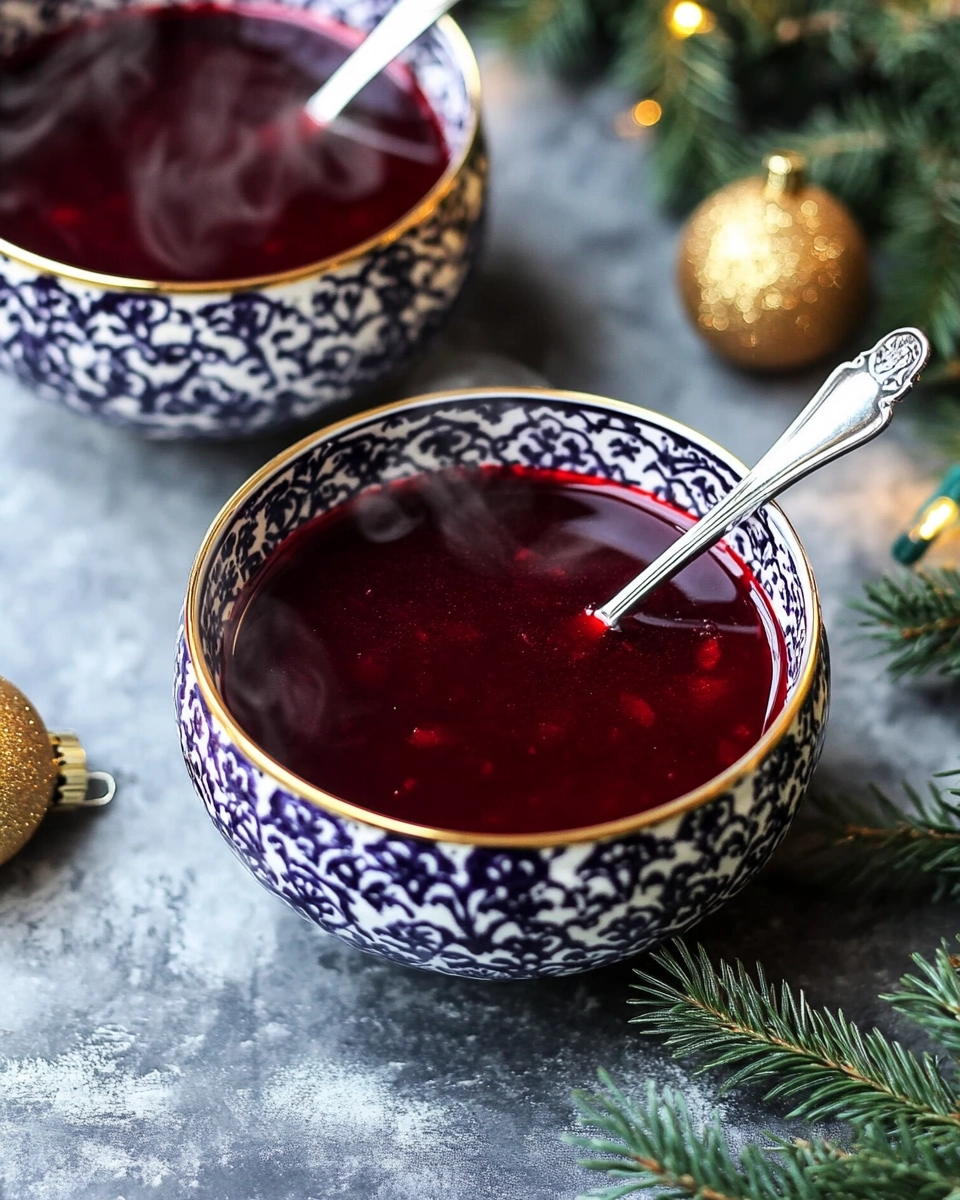Polish Borscht is one of those recipes that instantly transports you to a cozy Christmas Eve table in Poland, surrounded by family, the warm glow of candles, and the comforting aroma of beets simmering away. Known locally as barszcz czerwony, this clear red beet soup is more than just a dish—it’s a holiday tradition. Served piping hot, either in mugs for sipping or in bowls with delicate mushroom dumplings (uszka), Polish Borscht holds a special place on the Wigilia table, alongside other beloved Christmas Eve recipes.
In this guide, we’re going to walk through the cultural roots of this soup, its essential ingredients, the step-by-step method for getting that signature ruby-red clarity, alternative preparation methods like beet kvass, serving ideas, and a printable recipe card. Whether you’re a home cook wanting to reconnect with family traditions or a curious foodie eager to try something new, Polish Borscht will make your holiday table feel truly magical.
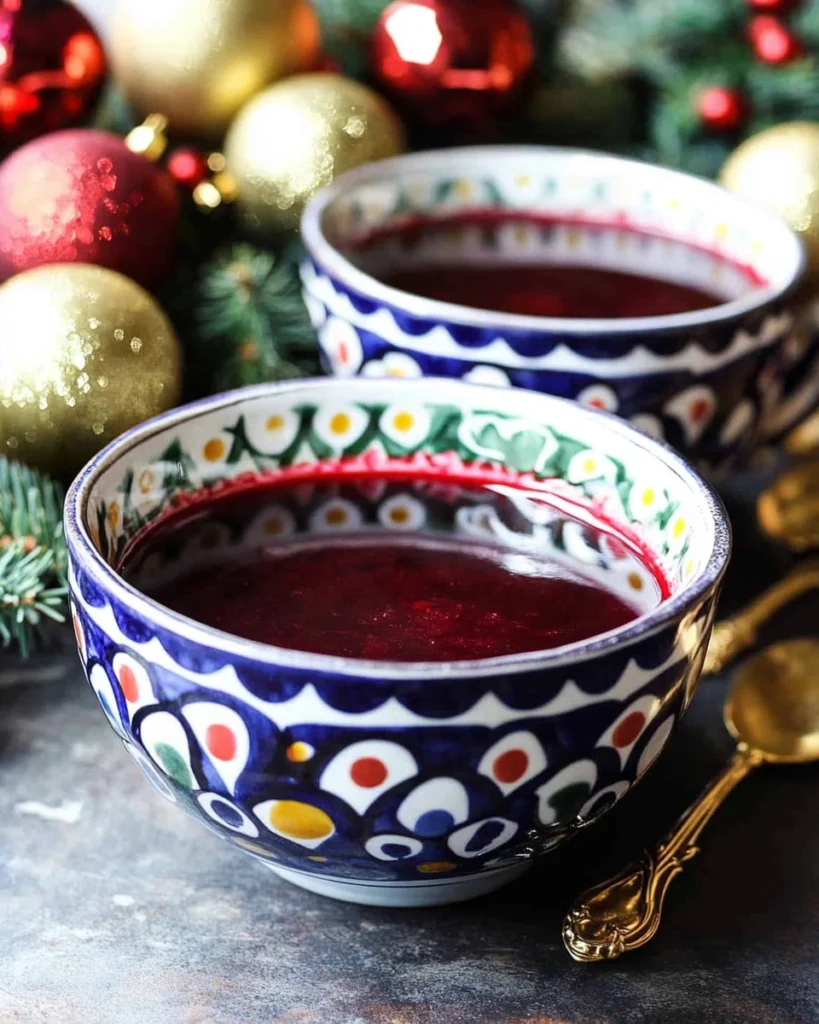
Jump to
The Cultural and Holiday Significance of Polish Borscht
To understand Polish Borscht, you need to know about Wigilia, the Polish Christmas Eve celebration. Wigilia is a meatless feast that often features twelve dishes—each symbolic, each steeped in meaning. Traditionally, families gather after the first star appears in the night sky, marking the start of the meal. The table is covered with a white cloth, often with hay tucked underneath to symbolize the manger, and an extra place setting is left for a wandering guest or absent loved one.
In many Polish homes, the first course is a soup—either clear red borscht or mushroom soup, depending on family tradition. Polish Borscht takes the starring role in countless households because of its deep color (symbolizing warmth and life) and its tangy, earthy flavor that pairs perfectly with dumplings.
While variations of beet soup exist across Eastern Europe, barszcz czerwony is distinct for its clarity and balance. This isn’t the chunky Ukrainian-style borscht with cabbage and potatoes; it’s a refined, almost jewel-like broth that celebrates the beet in its purest form. Many families pass down their Polish Borscht recipe like a treasure, tweaking seasonings but keeping the ritual intact.
If you’re already a fan of cozy soups, you might also love our hearty potato soup recipe for those chilly winter evenings.
Ingredients for Authentic Polish Borscht
The beauty of Polish Borscht lies in simple, fresh ingredients and a few carefully chosen aromatics. Here’s what you’ll need to make the most authentic version:
- Fresh vegetables: Beets (the heart of the soup), carrots, celery root, parsnip, leeks, parsley. These form the foundation of your vegetable broth.
- Apple: Adds subtle sweetness and a fruity note that balances the beets’ earthiness.
- Dry porcini mushrooms: A small amount adds a rich, earthy depth.
- Garlic: Brings gentle sharpness to the mix.
- Seasonings: Bay leaves, whole allspice berries, dry marjoram, salt, pepper, and sugar for balance.
- Acidity: White vinegar and lemon juice for brightness, or beet kvass for a fermented tang.
Optional garnishes include fresh dill or parsley. Some cooks add a splash of beet concentrate for color intensity.
This combination delivers that unmistakable aroma and taste people associate with Polish Christmas Eve soup. For a vegetarian twist, use a purely vegetable broth base, keeping it in line with Wigilia traditions.
Step-by-Step Cooking Instructions for Polish Borscht
Making Polish Borscht from scratch isn’t complicated—it just takes patience and a little love. Here’s the process broken down:
1. Soak the Mushrooms
Place your dry porcini mushrooms in a bowl with hot water for about 5 minutes. This step rehydrates them and releases that earthy flavor into the soaking liquid, which you’ll add to the broth later.
2. Build the Vegetable Broth
In a large pot, combine carrots, celery root, parsnip, leeks, parsley, the soaked mushrooms (with their liquid), bay leaves, allspice, and a pinch of salt. Cover with cold water and bring to a boil. Reduce the heat and simmer uncovered for about 30 minutes. This uncovered simmer allows the flavors to concentrate rather than dilute.
3. Prepare the Beets, Garlic, and Apple
Peel your beets carefully—yes, they will stain, so either wear gloves or just accept that your hands will look like you’ve been finger-painting with rubies. Slice the beets thinly for maximum flavor extraction. Slice the garlic and apple as well.
4. Combine and Simmer
Add the beets, garlic, apple, marjoram, vinegar, lemon juice, sugar, and another pinch of salt to the pot. Simmer uncovered for another 30 minutes. The kitchen will start smelling like Christmas memories.
5. Taste and Adjust
Now’s the time to fine-tune the flavor. Add more vinegar for brightness, sugar to balance acidity, and salt and pepper as needed. Polish cooks often taste several times before deciding the broth is “just right.”
6. Strain for Clarity
If you’re going for the classic clear red borscht, strain the broth through a fine sieve or cheesecloth. This leaves you with a vivid, jewel-like soup that’s both beautiful and delicious.
Pro tip: To preserve the bright red color, avoid overcooking once the beets are added, and keep the lid off so the color doesn’t dull.
If you enjoy from-scratch soup making, you’ll appreciate our chicken bone broth guide for stock-building techniques.
Alternative Preparation Methods for Polish Borscht
While the from-scratch method is traditional, there are a couple of shortcuts and variations worth mentioning:
Using Beet Concentrate
If you’re short on time, beet concentrate can stand in for part of the beets. It gives a bold color and concentrated flavor, letting you skip peeling and slicing multiple beets. Just add it toward the end and adjust seasoning.
Using Beet Kvass
For a fermented twist, replace vinegar and lemon juice with beet kvass. This adds a tangy complexity and keeps the recipe closer to old-world techniques. The only trade-off is that the probiotics in kvass won’t survive cooking, but the flavor is worth it.
Make-Ahead Tips
Polish Borscht freezes beautifully. Make it a week ahead of Christmas Eve, thaw gently, and reheat without boiling to preserve color.
Serving Polish Borscht the Authentic Way
Traditionally, Polish Borscht can be served in mugs for sipping or in bowls accompanied by dumplings. The most classic pairing is with uszka mushroom dumplings—tiny, delicate parcels of dough filled with minced mushrooms. Another popular option is serving it with sauerkraut and mushroom pierogi or potato and cheese pierogi.
Garnish with fresh dill or parsley for color. Some families enjoy bread on the side—rye bread pairs especially well.
For more dumpling ideas, see our vegetarian soup dumplings guide.
Related Polish Christmas Eve Recipes
To create a full Wigilia menu, try pairing Polish Borscht with other traditional dishes:
- Hearty Potato Soup Recipes – Creamy, filling, and perfect for chilly evenings.
- Authentic Caldo de Pollo Soup – A flavorful Mexican chicken soup full of fresh vegetables.
- Comforting Cabbage Roll Soup – All the flavor of stuffed cabbage rolls in a warm, cozy bowl.
If you like hearty Eastern European flavors, our cabbage roll soup is another great cold-weather choice.
Print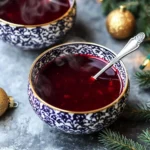
Polish Borscht (Barszcz Czerwony) – Traditional Christmas Eve Beet Soup
- Total Time: 1 hour 15 minutes
- Yield: 6 servings 1x
- Diet: Vegetarian
Description
Polish Borscht, or Barszcz Czerwony, is a clear red beet soup traditionally served on Christmas Eve in Poland. With its vibrant color, tangy-earthy flavor, and cultural significance, it’s a holiday classic often paired with mushroom dumplings (uszka).
Ingredients
- 5 medium beets, peeled and sliced
- 2 carrots
- 1 celery root
- 1 parsnip
- 1 leek
- Handful fresh parsley
- 1 apple, sliced
- 2–3 garlic cloves, sliced
- 3–4 dry porcini mushrooms
- 2 bay leaves
- 3–4 whole allspice berries
- 1 tsp dry marjoram
- 1 tbsp sugar
- 2 tbsp white vinegar
- Juice of 1 lemon
- Salt and pepper to taste
Instructions
- Soak mushrooms in hot water for 5 minutes.
- Combine carrots, celery root, parsnip, leek, parsley, mushrooms with soaking liquid, bay leaves, allspice, salt, and enough water to cover in a large pot. Bring to a boil, then simmer uncovered for 30 minutes.
- Add sliced beets, garlic, apple, marjoram, vinegar, lemon juice, sugar, and salt. Simmer uncovered for another 30 minutes.
- Taste and adjust seasonings.
- Strain for a clear broth. Serve hot in mugs or bowls.
Notes
For the brightest color, avoid overcooking the beets and keep the lid off during simmering. Serve with uszka dumplings for the most authentic experience.
- Prep Time: 15 minutes
- Cook Time: 1 hour
- Category: Soup
- Method: Stovetop
- Cuisine: Polish
Nutrition
- Serving Size: 1 cup
- Calories: 107
- Sugar: 11g
- Sodium: 300mg
- Fat: 0g
- Saturated Fat: 0g
- Unsaturated Fat: 0g
- Trans Fat: 0g
- Carbohydrates: 25g
- Fiber: 5g
- Protein: 2g
- Cholesterol: 0mg
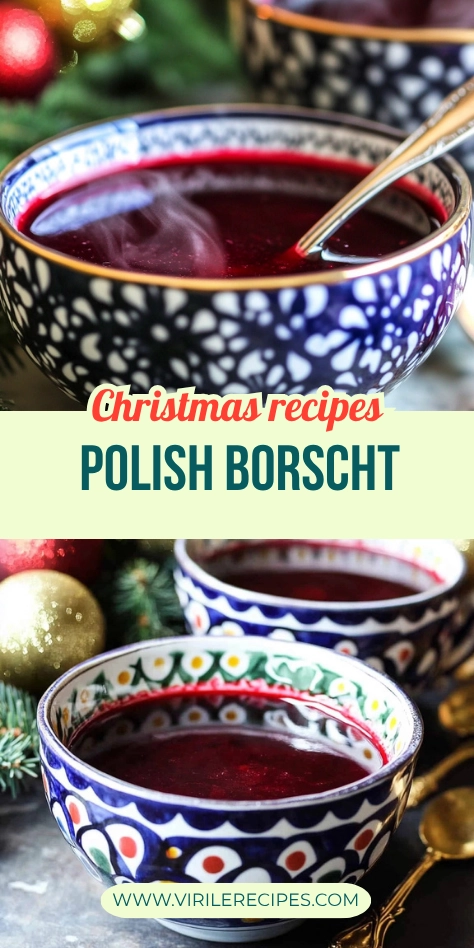
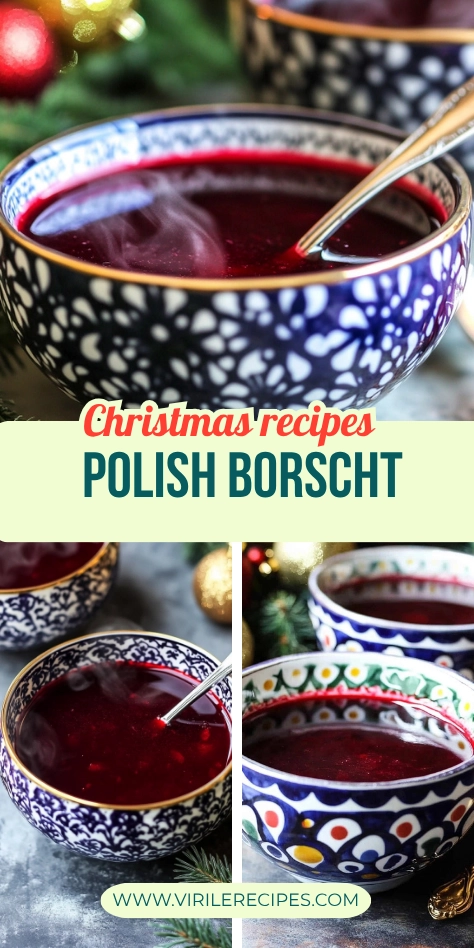
Final Thoughts
Polish Borscht is more than just a soup—it’s a connection to centuries of tradition, a splash of vibrant color on a winter table, and a warm, tangy hug in a cup. Whether you serve it with dumplings or sip it on its own, it’s a dish that invites conversation, laughter, and togetherness. I hope this recipe brings you as much joy in making and sharing it as it has brought to my own holiday gatherings.
And add at the end with links (Follow us for more drool-worthy comfort food on Pinterest and join the conversation on Facebook.

